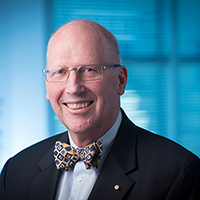Despite the pandemic interrupting plans, the University’s Indigenous Eye Health team is on track to eliminate trachoma and to Close the Gap for Vision.
After decades of watching public health campaigns try and fail to make meaningful improvements to Indigenous health in Australia, Melbourne Laureate Professor Hugh Taylor AC set up the Indigenous Eye Health Unit (IEHU) at the University of Melbourne in 2008.

The following year his team and the Centre for Eye Research Australia (CERA) carried out the National Indigenous Health Survey, which found that Indigenous Australians experienced six times more blindness than other Australians, and three times more low vision. A staggering 94 per cent of that vision loss was due to preventable or treatable diseases such as trachoma, a painful bacterial infection that can lead to blindness. Today, Australia is the only developed nation where trachoma persists, despite being eliminated from the non-Indigenous population more than 100 years ago.

Professor Taylor, who began working on the disparity between Indigenous and non-Indigenous health in Australia with the late Fred Hollows AC in the 1970s, says his team was poised to reach their goal of eliminating trachoma last year: rates in endemic areas had fallen from 21 per cent in 2008 to just four per cent in 2019.
But then the pandemic happened. Despite some setbacks over 2020, the work of the Indigenous Eye Health Unit, in collaboration with communities, has seen trachoma eliminated in more than 150 communities Australia-wide.

They have also improved the regional delivery of eye care by establishing partnerships that now cover 95 per cent of the country. This has helped increase eye exams three-fold and more than doubled cataract surgery patients.
Professor Taylor says none of this work could have been carried out without the generous support of our donor community.
“I feel extremely privileged to have been appointed the Harold Mitchell Chair of Indigenous Eye Health at the University of Melbourne. Thanks to the philanthropic support of private trusts, foundations and individual donors who made our work possible, we were also able to gain more backing from government.”
“When we started, there was six times as much blindness in Indigenous communities as in non-Indigenous communities,” he says. “By 2015-16 this was halved.”
And there is even more encouraging news. According to a recently published Commonwealth report entitled Indigenous eye health measures 2020, between 2010-11 and 2018-19 the proportion of Indigenous Australians who had an eye health check increased from 11 per cent to 30 per cent.
Although trachoma and avoidable vision loss are yet to be fully stamped out in Australia, there is no doubt Professor Taylor and his team have made significant inroads and the future looks promising, with the Commonwealth and States recently committing to ending avoidable blindness in Indigenous Australians by 2025.
We could not have done this work without the great philanthropic support from private Trusts, Foundations and individual donors.
— Melbourne Laureate Professor Hugh Taylor AC, Harold Mitchell Chair of Indigenous Eye Health at the University of Melbourne